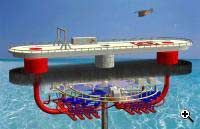In the late 1800’s, the French physicist Jacques Arsene d’Arsonval proposed a method for generating electricity using the sea as a giant solar-energy collector. It is considered that the technology, termed “Ocean Thermal Energy Conversion” (OTEC), may enable the establishment of an efficient energy storage system across the world, supplying enough energy for our entire planet.
OTEC is based on the idea of exploiting the differences in temperature between deep waters and surface waters in order to generate electric power. Shallow ocean waters can heat up to a temperature of 29C in the tropics. Only one kilometer below these warm waters, temperatures are significantly lower, often falling below 5C. These extreme temperature differences are used to operate vapor turbines, which drive generators to produce electricity. Experts estimate that on an average day, 60 million square kilometers of tropical seas absorb an amount of solar radiation that is equal in heat content to about 250 billion barrels of oil. To get a better perspective on these numbers, this actually means that less than 0.001% of this energy converted into electric power would be sufficient to supply over 20 times the electricity consumed daily in the United States.
A team of British architects, including Dominic Michaelis, Alex Michaelis, and Trevor Cooper-Chadwick, are currently working on a project they hope will bring the century-old idea back to life. They have proposed to construct a network of “floating platforms”, which in addition to being OTEC power generators, will be equipped with wind and wave turbines. In this way, the platforms will simultaneously exploit a number of natural energy sources to provide ‘around the clock’ electricity. The scientists say that a single “island” of this design will be able to produce around 250MW, while 50,000 of these "islands" will be able to meet the daily energy requirements of the entire world's population.
The architects say that an OTEC plant will not only be a supplier of green energy, but due to its unique conversion process, will also provide desalinated water as a byproduct. In addition to about 300,000 liters of fresh water each day, the OTEC plant may also be used to produce hydrogen fuel by using electrolysis. Alex Michaelis envisions the islands themselves as home to workers, who will operate and maintain the plants. Michaelis envisions the inhabitants will be able to grow seafood and vegetables, living and working in rotations on the islands.
Many critics have questioned the viability of the 50,000 artificial islands system, saying it is unlikely that the project can be implemented cost-efficiently. In response to this criticism, Michaelis says that "If we consider that we are at war to find a new form of clean energy, wartime effort in World War II produced vast numbers of planes, tanks, ships and other armaments on both warring sides. 20,300 Spitfires alone were built, making the construction of more than 50,000 of these plants seem a reasonable number."

